FRONT-WHEEL DRIVE
Front-wheel drive (FWD) vehicles often use a transverse (sideways) engine. The smaller four cylinder engines and the 60° V6 are suited for small car, FWD use, although there are some 90° V6 engines in FWD vehicles; larger engines tend to be used in rear-wheel drive (RWD) vehicles.
Some manufacturers have used large engines in FWD cars. If FWD drive shafts are not of equal length, a car with substantial horsepower will experience torque steer. Torque steer is when the vehicle pulls to one side under heavy acceleration.
ENGINE CLASSIFICATIONS
Engines are classified according to their displacement and valve arrangement. Displacement refers to the volume that the piston displaces in the cylinder. The engine's total displacement is determined by multiplying:
Bore^2 × Stroke × 0.7854 × Number of Cylinders = Displacement
The larger the displacement, the larger the engine. Engine size in North American vehicles used to be described in CID, or cubic inch diameter.
In late-model vehicles, volume is described in liters or cubic centimeters. (Converting between metric system measurements and English system measurements is covered.) Another means of determining displacement is to multiply the swept volume of the cylinder by the number of cylinders.
Swept volume is determined by multiplying:
Bore/2 × Bore/2 × Stroke × _ (3.14) = Swept Volume
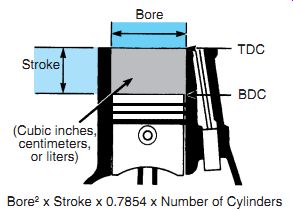
Fig 1.26 Displacement is a measurement of the cylinder's volume. Bore
Stroke (Cubic inches, centimeters, or liters) TDC BDC
Bore2 x Stroke x 0.7854 x Number of Cylinders
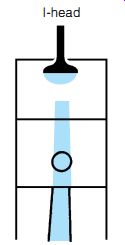
Fig 1.27 When the valves are in the cylinder head, the engine is known
as an I-head engine.
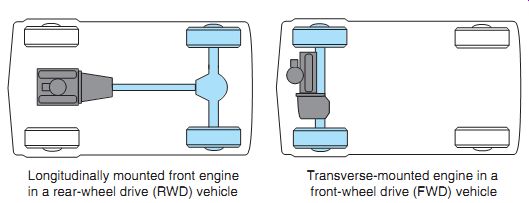
Fig 1.25 Rear-wheel drive (RWD) and front-wheel drive (FWD) engines. Transverse-mounted
engine in a front-wheel drive (FWD) vehicle; Longitudinally mounted front
engine in a rear-wheel drive (RWD) vehicle
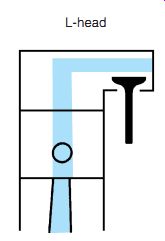
Fig 1.28 An L-head, or flathead, engine has the valves in the block. L-head
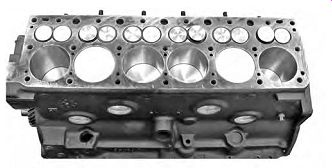
Fig 1.29 A flathead Studebaker block with the head removed.
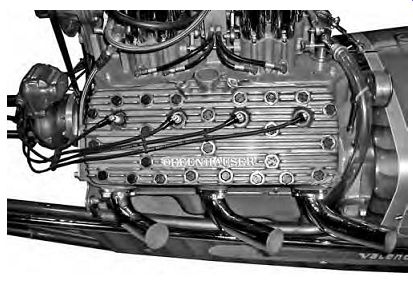
Fig 1.30 A flathead V8 engine from a vintage dragster.
CLASSIC ENGINE---Until the early 1950s many automobiles had L-head engines whose valve configuration resembles the letter L upside down. These engines, also called flatheads or sidevalves, are still used in lawnmowers, generators, and other industrial engines. L-head engines are less expensive to manufacture, but they produce more smog due to the high amount of surface area exposed to unburned fuel. Flatheads are also limited in their compression ratio and valve lift. Increased valve lift requires more clearance in the combustion chamber, which would lower compression.
The figure shows an L-head Studebaker engine with the cylinder head removed.
Notice how the valves are located in the block. Flatheads were very popular with early hot rodders and racers. A popular hot-rodding trick was to remove the cylinder head (a relatively easy thing to do) and mill it to increase the compression ratio.
Valve Arrangement
Modern engines use an overhead valve (OHV) arrangement known as I-head or valve-in-head. This design has a more direct path of air-fuel flow than earlier engine designs. Fewer exhaust emissions are produced because of the smaller amount of surface area in the combustion chamber. When cool engine surfaces are exposed to unburned fuel, a skin effect occurs and the unburned fuel ends up in the exhaust stream.
Increasing the valve opening, called valve lift, to a certain point is necessary to allow enough air fuel mixture into the cylinder to develop maxi mum power. Increased valve lift is possible with the I-head engine design. This is because as the intake valve opens, the piston is moving down in the cylinder, providing clearance. When the exhaust valve is wide open, the piston is near the bottom of the cylinder, providing plenty of piston to-valve clearance as well. If more air-fuel mixture is packed into the cylinder, more power will be developed. This is called volumetric efficiency, which is the reason that supercharging is so effective in producing extra power from relatively small engines. In supercharged engines, an air pump compresses more air-fuel mixture into the cylinder.
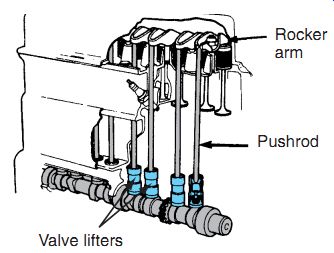
Fig 1.31 Some overhead valve (I-head) engines use pushrods to operate
rocker arms. Rocker arm Pushrod; Valve lifters
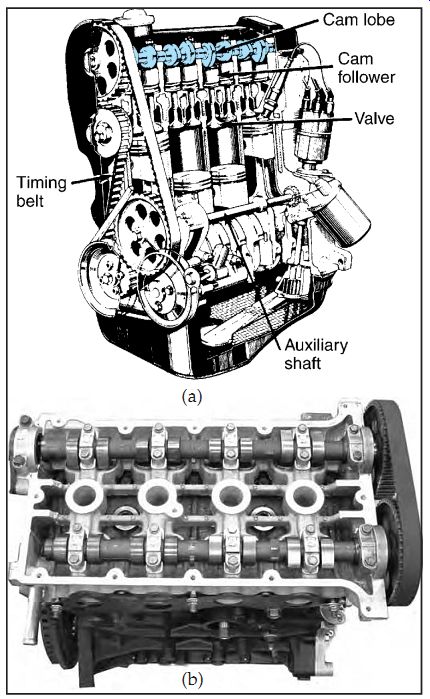
Fig 1.32 In-line four cylinder overhead cam engine. (a) An OHC engine
with the cam positioned over the valve. (Chrysler). (b) A dual overhead
cam (DOHC) engine.
Cam-in-Block or Overhead Cam
Some I-head engines have the camshaft located in the block. This engine design is called a pushrod engine, or cam-in-block engine. Cam lobes raise valve lifters that act on pushrods to operate rocker arms and open the valves. In late-model vehicles, push rods are found most often on V-type engines.
A more popular type of valve operating arrangement for late-model engines is the overhead cam design, or OHC. This engine has the camshaft mounted on top of the cylinder head just above the valves. It has the advantage of having fewer parts and less weight. An engine running on the freeway at 3000 rpm has to open and close a valve 25 times per second, so valvetrain weight is very important. It’s even more important in high-speed engines.
Some OHC engines have a single cam (SOHC). Each cylinder is provided with two separate lobes to operate the intake and exhaust valves. High performance OHC engines often have two cams per cylinder head. On this design, known as dual over head cam (DOHC), one camshaft operates the intake valves and the other operates the exhaust valves. DOHC engines have become more common in recent years as the base engine of many vehicle manufacturers.
The OHC engine uses a long chain or belt from the crankshaft to the cylinder head to drive the cam(s) +. When the ignition system uses a distributor, some OHC engines use an auxiliary shaft to drive it, whereas others have a crankshaft driven distributor.
CLASSIC ENGINE---OHC was limited in the past to smaller, in-line engines, except for its use in luxury or racing automobiles. In recent years, belt-driven OHC engines have become commonplace.

Fig 1.33 V-type overhead cam engines. (a) Belt-driven overhead cam V6.
(b) Chain-driven overhead cam V8.

Fig 1.34 A wedge combustion chamber.
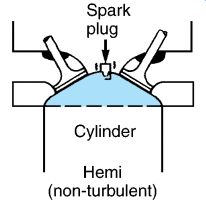
Fig 1.35 A hemispherical combustion chamber.
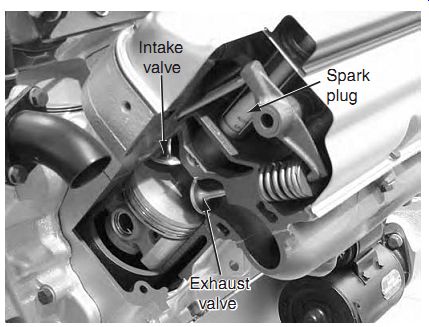
Fig 1.36 A cutaway of a Chrysler hemi head. The valves are on opposite
sides with the spark plug in the center. Intake valve; Exhaust valve; Spark
plug; Exhaust valve
CLASSIC ENGINE---The stratified charge design is the type pioneered by Honda. The name comes from the stratification, or layering, of different densities of air-fuel mixtures. Honda and Mitsubishi used a very small amount of rich mixture to ignite a very lean (normally unburnable) mixture in a small pre-combustion chamber. When it was ignited by the spark plug, the advancing flame front from this small, rich mixture ignited the leaner mixture in the main cylinder.
This made it possible for the engine to run on an air-fuel mixture leaner than normal. Today's direct-injected engines use a stratified fuel charge.

Fig 1.37 In this stratified charge head a small valve in the precombustion
chamber provides the rich air-fuel mixture needed to ignite the lean mixture
in the main combustion chamber. Spark plug Precombustion chamber; Precombustion
chamber intake valve; Intake valve; Lean mixture; Main combustion chamber;
Rich mixture
COMBUSTION CHAMBER DESIGNS
The principal combustion chamber designs are the hemi, the wedge, and the pent-roof. There are also some combustion chamber designs with "D" or heart shapes. The wedge is the most common combustion chamber design with pushrod engines. It has a squish/quench area that causes movement (turbulence) of the air-fuel mixture and cooling of the gases to prevent abnormal combustion. This movement causes more complete burning at lower speeds with less chance of detonation.
There are turbulent and nonturbulent combustion chambers. Turbulent combustion chambers, like the wedge, can cause air and fuel to separate from each other at high speeds. A nonturbulent combustion chamber, the hemispherical (hemi) design, is more efficient for high-speed use. Because the mixture is centered near the spark plug, the flame spreads evenly. A hemi chamber allows the use of bigger valves, too. Some times hemis have a tendency to "spark knock" on lower octane fuels. Diesel engines have no chamber in the cylinder head itself; the combustion chamber side of the head is virtually flat. Turbulence and squish in the cylinder are controlled by the shape of the piston head.
A pent-roof combustion chamber is shaped like a "V." This design is popular for use with four valve-per-cylinder designs. The pent-roof and other newer designs are designed for more efficient combustion and better emission control. In a high swirl chamber, like in the wedge chamber, areas on the head surface are raised to cause a planned turbulence of the air-fuel mixture.
DIRECTION OF CRANKSHAFT ROTATION
The front of the engine is the side opposite the transmission. The front of most engines includes the camshaft drive, a timing cover or front cover, and the crankshaft vibration damper or pulley.
Volkswagen has some engines that have the timing cover at the rear of the engine.
The Society of Automotive Engineers (SAE) standard for engine rotation says that automotive engines rotate counterclockwise when viewed from the fly wheel end of the engine. This means that longitudinally mounted engines (called front to rear or north to south) turn clockwise when viewed from the front.
Transverse mounted (sideways) engines also follow this standard, although a few engines (Honda, for instance) rotate in the opposite direction.

Fig 1.38 A four cylinder engine has one cylinder on a power stroke during
every 180° of crankshaft rotation.
FIRING ORDER
To make a smooth-running engine, multiple cylinder engines have their power strokes spaced at specified intervals. In a four cylinder engine, one cylinder starts a power stroke at every 180° of crank rotation. This interval between power strokes is known as the ignition interval.
Cylinders are fired in a sequential order known as the firing order. The firing order does not usually follow the order of cylinder numbering. + --- several ways of determining an engine's firing order. Sometimes the firing order is found cast into the surface of the intake manifold for easy reference.
TIP---Most V-type engines have one bank of cylinders positioned farther forward than the others. The cylinder closest to the front is usually the one denoted as number 1.
Companion Cylinders
Engines with an even number of cylinders have pairs of cylinders called companion cylinders, or running mates. Pistons in companion cylinders go up and down in pairs. When one piston is starting its power stroke, its companion piston is at the start of its intake stroke. To find out which cylinders are companions, take the first half of the engine's firing order and place it above the second half. For a V8 with a 1 8 4 3 6 5 7 2 firing order, put numbers 1, 8, 4, and 3 above numbers 6, 5, 7, and 2. The resulting pairs are companions.
- first revolution 1 8 4 3
- second revolution 6 5 7 2
Remember, during a complete four stroke cycle the crankshaft will revolve twice (720°). The first half of the firing order represents the first crankshaft revolution (360°) and the second half of the firing order represents the second revolution (360°).
In the preceding example, when cylinder number 7 is beginning its intake stroke, cylinder number 4 is beginning its power stroke. This is an eight cylinder engine so one power stroke occurs during every 90° of its 720° four stroke cycle.
It appears at first glance that a single cylinder engine would require the same airflow into its cylinder as a four cylinder engine with cylinders of the same displacement because the four stroke engine only uses the intake manifold during the intake stroke. In actual practice, however, the engine breathes air and fuel for a period longer than the intake stroke's 180° of crankshaft rotation (refer to the chart). The valve starts to open before TDC and closes after BDC when the crank shaft has traveled considerably into the compression stroke. The reason for this is to allow the cylinder to fill with as much air-fuel mixture as possible.
An in-line six cylinder engine has one power stroke every 120° of its 720° four stroke cycle.
If the engine were carbureted instead of fuel injected, a single carburetor on this engine would have to be larger so it could serve more than one cylinder at a time because of the overlapping intake strokes.
Next: Basics of Engine Operation (part 3)
Prev.: Basics of Engine Operation (part 1)
Home Article Index top of page